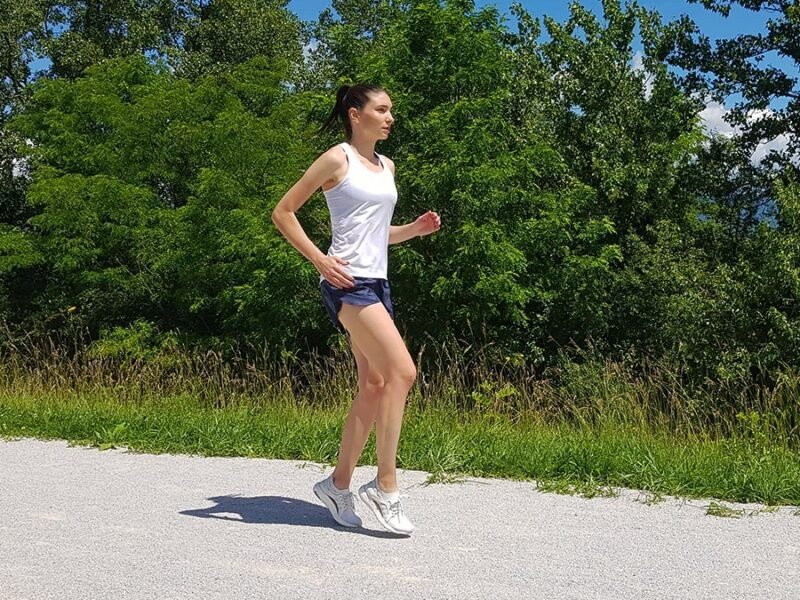How To Properly Do Ankling Drill? (Step-by-Step)
There are several exercises which engage your feet, ankling being one of them.
In this article, I will explain how to properly do ankling and I will answer the frequently asked questions.
What is ankling?
Ankling is a simple running drill and is an integral part of a warm-up before running. It develops proper mechanics for landing during a run, as well as ankle mobility and strength. It also increases the frequency of steps, which makes a more efficient runner.
How to do ankling properly?
- Begin by standing with your feet hip-distance apart, look straight ahead, and keep your upper body straight.
- Step forward with your right foot and land on the ball of your foot while standing on your left leg.
- Shift your weight from your left to your right leg by transferring the weight from the ball of your foot to the heel so that each part of the foot comes in contact with the ground.
- Continue alternating sides and moving forward.
Make your steps quick and small. Your arms should follow your leg movements, as they do during a run.
Tips for performing ankling properly
- Try to raise your knees as little as possible, just enough for the foot to go through the full range of motions.
- Mind your posture. Keep your body straight; do not bend forward or backward.
- Focus on quick movements; reduce the time spent in contact with the ground.
- Do not forget to move your arms. Swing the arm opposite the raised leg.
It is important that you focus on the proper execution of the ankling.
As I have mentioned already, quick leg movements are important, but proper form is essential.
Start with slower movements and accelerate gradually, staying in control of your movements.
Read more: Top 8 Running Drills To Improve Your Form [Video]
What muscles does ankling target?
Ankling develops strength, stability, and the functional range of motion of the ankle.
Major muscles used during ankling include:
- Calf muscles
- Tibialis anterior
- Foot flexor muscles
Ankling benefits
Besides being part of a warm-up routine before more intensive training or races, ankling also has other benefits.
1. Improves running technique
Ankling improves running technique by teaching you the proper mechanics of landing during a run.
Running speed and distance affect the way you hit the ground with your feet.
Regardless of the way you hit the ground, it is important to avoid heavy landing and overstriding.
2. Increases cadence
Ankling teaches you not to overstride and to avoid running over your heels.
By running with steps of proper length you maintain your momentum and avoid slowing down.
That way you increase your running cadence (number of steps in a minute).
Research has shown that increasing cadence by 10% reduces the stress on your knees by 5%. This reduces the risk of usual runner injuries, such as hip or knee injuries.
3. Improves neuromuscular effectiveness
Ankling improves communication between nerves and muscles by quickening nerve impulses that send signals to muscle fibers.
As a result, your muscles will have better coordination in more intensive training or race.

4. Warms up shin muscles, and develops strength and mobility of ankles
Muscles, tendons, and ligaments of the shin are extremely important for runners, and they often suffer from injuries.
As a result, it is important to warm them up well before any activity.
Among them is the Achilles tendon, the thickest and strongest tendon in the body, which connects calf muscles with the heel bone.
Info
During a run, the Achilles tendon endures a force greater than seven times the weight of the body.
As you come in contact with the ground the Achilles tendon absorbs the force like a spring.
All the energy absorbed during contact with the ground is released as you push off it.
The ankle and foot offer mobility and stability while dispersing the force during landing.
They support the weight of the body during a run.
As a result, if you want to be a successful runner, you have to strengthen and activate your feet, as well as learn how to properly be in contact with the ground.
5. Intended for all runners
Ankling is a simple drill and is easy to learn, which makes it appropriate for beginners, as well as advanced runners.
How and when to include ankling in your training?
Ankling is a running drill used in warm-up routines before more intensive training or races.
Also, you can use it after an easy jog, when you are not as tired, so you can focus on the proper execution of the exercise.
Ankling can be done in place or by moving forward 20 to 40 meters and then resting as you walk back to your starting position.
Example of a warm-up routine before interval training (8 x 400m)
1. Easy jogging (10 minutes)
2. Mobility exercises and dynamic stretches (5 minutes)
3. Running drills – 2 x 40m ankling, 2 x 40m high knees
4. Strides – 3 x 60m
Read more: Warm-up Before Running [Ultimate Guide]

Matea Matošević
Hi, I’m Matea! I’m an Olympic Marathon Runner, founder, and writer behind OLYRUN.com. On this site, I provide help in the form of my knowledge and experience to all who love running and active living. Read more…
